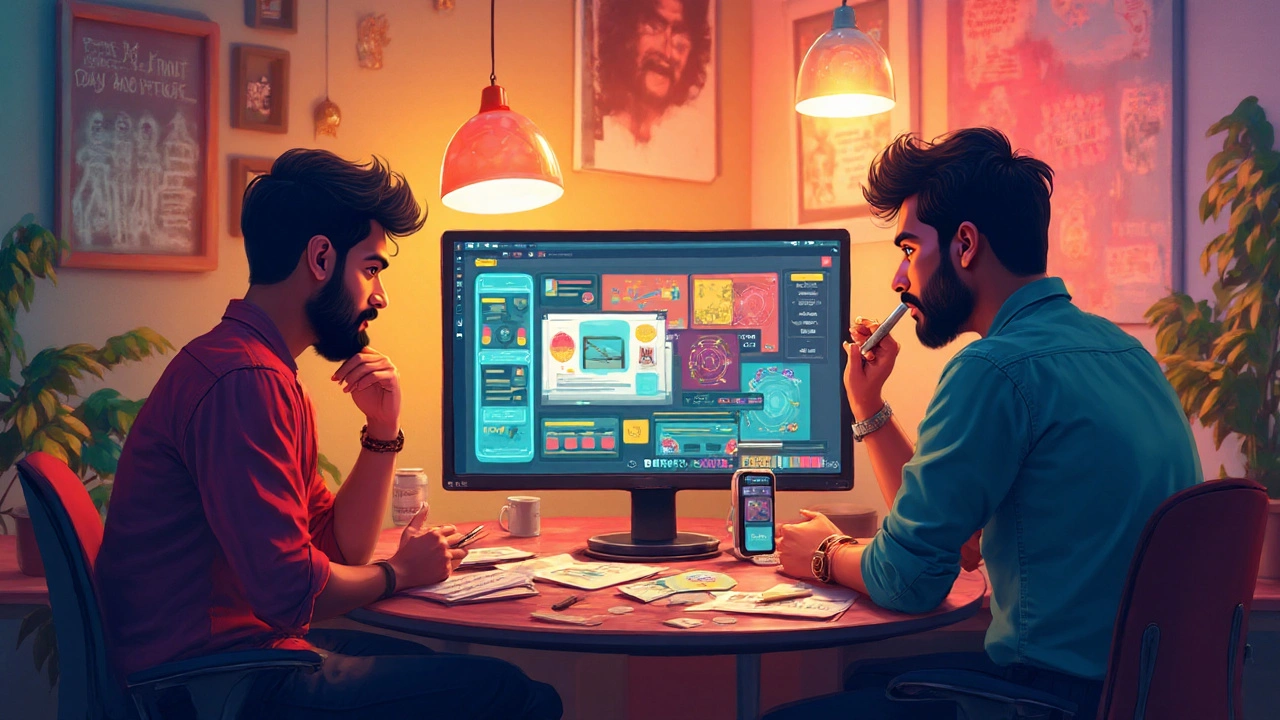UX UI Design: What It Is and Why It Matters
When working with UX UI Design, the combined practice of shaping how users feel and what they see in digital products. Also known as User Experience & Interface Design, it drives engagement, cuts friction, and lifts conversion rates. UX UI Design encompasses two core disciplines: User Experience (UX), the study of user needs, behaviors, and emotions and User Interface (UI), the visual layout, typography, and interactive elements. The synergy between UX and UI creates products that are both useful and beautiful. A crucial part of that synergy is the toolset designers rely on; Figma, a cloud‑based design platform that enables real‑time collaboration has become the go‑to solution for wireframes, prototypes, and design systems. In short, UX UI Design includes research, wireframing, prototyping, testing, and visual refinement, while requiring tools like Figma to turn ideas into clickable experiences. This layered approach means a single project can move from user interviews to high‑fidelity screens without leaving the same workspace, which speeds up feedback loops and keeps stakeholders in the loop.
Key Steps and Skills Every Designer Should Know
Start with user research: surveys, interviews, and analytics give you the data you need to map out pain points. Next, translate that data into low‑fidelity wireframes that outline the information hierarchy. From there, build interactive prototypes in Figma or similar tools to validate flows before any code is written. Usability testing—whether in‑person or remote—lets you catch friction early, and the insights feed back into the design iteration cycle. Along the way, designers often adopt design systems, a collection of reusable components that ensure consistency across screens and platforms. These systems save time, improve accessibility, and make handoff to developers smoother.
The articles in this collection reflect the full spectrum of what you’ll encounter in the field. You’ll read about the day‑to‑day tasks of UI/UX designers, explore whether you can break into UX with no experience, and see how salaries compare across roles. Other posts debunk myths about coding requirements, break down the math behind layout decisions, and explain why tools like Figma have reshaped teamwork. Whether you’re a beginner curious about the career path or a seasoned pro looking for salary benchmarks, the posts below give practical tips, real‑world examples, and clear steps you can apply right now. Ready to dive deeper? Scroll down and discover the insights that will help you master UX UI Design and take your digital projects to the next level.
Is Learning UX Worth It in 2024? Pros, Salary & Career Outlook
- Jaxon Millwater
- UX UI Design
- 0 comment
Explore if learning UX in 2024 is worth it, covering salary trends, skill paths, job outlook, and a practical decision checklist.
VIEW MOREWhat UI/UX Designers Actually Do: Roles, Skills, and Daily Tasks
- Jaxon Millwater
- UX UI Design
- 0 comment
Discover the real daily tasks of UI/UX designers, from research and wireframing to visual design, testing, and collaboration, and learn the skills needed to succeed.
VIEW MOREWhat Is UX UI Design? A Clear Guide to User Experience & Interface
- Jaxon Millwater
- UX UI Design
- 0 comment
Discover what UX UI design really means, its key components, process steps, and how it shapes digital products. A practical guide for designers and developers.
VIEW MORECan You Get Into UX Design With No Experience? 2025 Beginner’s Guide to Your First Job
- Jaxon Millwater
- UX UI Design
- 0 comment
Yes, you can start UX with no experience. Here’s a clear 2025 plan: skills to learn, free ways to get real projects, portfolio tips, UK salary ranges, and interview prep.
VIEW MOREUX vs UI: Which Design Discipline is More Challenging?
- Jaxon Millwater
- UX UI Design
- 0 comment
Is UX really harder than UI? Dive into the debates and differences, learn what each job actually involves, and get tips on choosing your design path.
VIEW MOREDoes UI/UX Require Coding? Essential Guide for Designers
- Jaxon Millwater
- UX UI Design
- 0 comment
Does UI/UX design require coding? Uncover the reality, skill set needs, and tips for entering user interface and user experience design without a CS degree.
VIEW MOREIs UI UX a Coding Job? Demystifying the Designer's Role
- Jaxon Millwater
- UX UI Design
- 0 comment
Is UI UX design all about coding, or is there more to it? This article uncovers what UI and UX designers really do, how much coding actually matters, and which skills you actually need to break into the field. You'll find out where creativity meets technology, what hiring managers are actually looking for, and some practical tips to help you focus your learning if you're aiming for a UI/UX job. All the jargon is stripped away, making the path forward easy to understand.
VIEW MOREIs UX Design a High Paying Job? Real Numbers & Surprises
- Jaxon Millwater
- UX UI Design
- 0 comment
Curious if UX design brings in serious cash? This article dives right into current salaries, what influences paycheck size, how to boost your earnings, and what hiring managers want to see. You'll get easy-to-understand facts, not myths. Perfect for anyone thinking about a career change or leveling up in UX.
VIEW MOREDoes UX Design Need Math?
- Jaxon Millwater
- UX UI Design
- 0 comment
UX design is often seen as a creative field, but does it really require math skills? This article breaks down the role of math in UX design, explains where math intersects with the design process, and whether aspiring designers should sharpen those math skills. Discover how math can help in understanding user data, creating balanced layouts, and more.
VIEW MOREUnlocking the Potential of Figma in UX/UI Design
- Jaxon Millwater
- UX UI Design
- 0 comment
Figma has revolutionized the UX/UI design world with its cloud-based interface, making collaborative design projects seamless and efficient. Known for its versatility, Figma allows designers to work on web and app interfaces with ease, ensuring real-time collaboration. Offering a treasure trove of features like prototyping, asset library, and plugins, it's a one-stop solution for both individual designers and large teams. Discover how Figma can enhance your design process and creativity.
VIEW MOREWeb Developer vs. UX Designer: Who Brings Home More?
- Jaxon Millwater
- UX UI Design
- 0 comment
Curious about whether a web developer or UX designer earns more? This article unpacks the salary differences, highlighting what each role entails and how their earnings stack up. We dive into market trends, skill requirements, and job satisfaction to help you understand the financial prospects of these in-demand careers. Perfect for anyone considering a tech career or looking to switch roles.
VIEW MOREGuide to Becoming a UX Designer: Skills, Tips, and Pathways
- Jaxon Millwater
- UX UI Design
- 0 comment
Becoming a UX designer involves understanding user needs, mastering design tools, and creating intuitive interfaces. This article provides insights into the skills and qualifications required to enter the UX design field. It also discusses paths to learning UX design, from formal education to self-study approaches. Discover essential tips for building a portfolio and finding your first job in UX design. The journey may seem complex, but with the right guidance, you can become a sought-after UX designer.
VIEW MORECategories
- Responsive Web Design (14)
- Tech Careers (13)
- SEO for Web Developers (12)
- UX UI Design (12)
- PHP Development (11)
- Web Development Courses (11)
- JavaScript (9)
- Ecommerce Websites (9)
- Web Development Frameworks (8)
- Full Stack Development (8)
Popular posts
-
Landing a Full‑Stack Developer Job Without a Degree - Your Guide
Jaxon Millwater -
Do Web Developers Work 40 Hours? Real Schedules, Overtime, and Work-Life Balance (2025)
Jaxon Millwater -
Can I Be a Web Developer as a Side Hustle? What You Need to Know
Jaxon Millwater -
What Replaced PHP? Modern Server‑Side Alternatives Explained
Jaxon Millwater -
Top Countries for Full-Stack Developers in 2025
Jaxon Millwater











